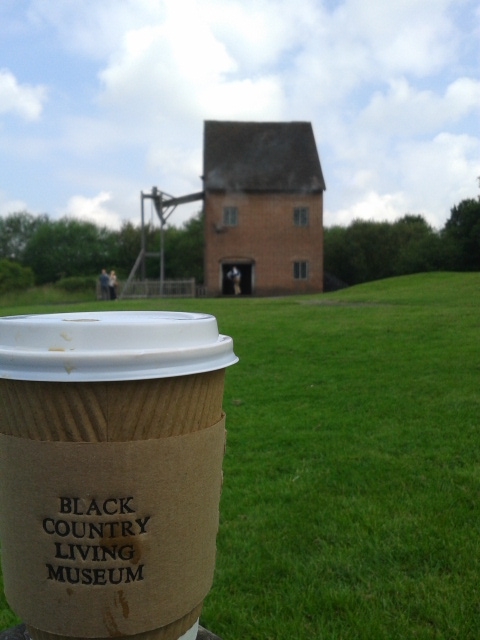
Sitting outside with my free coffee, watching a demonstration of the Black Country Museum’s Newcomen engine
Attending the AIM conference has been a valuable addition to my traineeship. I was able to attend through a bursary provided to me through our region’s Museum Development Officer, Rachel Lambert-Jones, but even if I had paid for the day I would have thought it good value for money. It was inspiring to meet people from all over the country who are each facing similar troubles in this economic climate, and yet achieving great things. I attended two seminars: Augmented Reality and Supporting Industrial Heritage, and attended the morning talks where speakers from the Black Country Living Museum, Avoncroft Museum of Historic Buildings and Beamish presented their sites as Case Studies. All of these sites have been success stories, but none have had such a change in fates as Avoncroft. It was fascinating to hear how this site had managed to move from being almost derelict to becoming a sustainable and popular visitor attraction.
Peter Bazelgette from Arts Council England also gave a talk and answered questions from the audience. It was enlightening to hear him speak about the political situation regarding the Arts at present and encouraging hearing about the work that ACE is doing to try to keep the Arts as high up on the political agenda as possible. I felt considerably more sceptical, however, when he was asked a question about the funding imbalance between London and the rest of the country. He said that they did not want to ‘damage’ London by taking away lots of the funding from there at once; that London was the ‘cultural capital of the world’, and therefore London’s success would impact on the rest of England favourably. From what he said I do feel that the Arts Council are addressing the issue, but I think that more could be done to make any meaningful difference in the rest of the country.
After lunch were the seminars, where delegates split into smaller groups. These were very practical sessions, offering advice on a number of different subjects. I chose to attend the seminar on Augmented Reality Apps because I was interested in the kinds of new technology that we will be able to use in museums in the near future. The app showcased in this seminar is being developed by the University of Surrey and will hopefully allow museum visitors to interact with art/objects in new ways. For example, when using the app’s camera function, new layers of information are placed upon objects – holding up the tablet or phone to a piece of art gives the option to ‘click’ on the screen. Then the user can either hear more information on this piece, or add their own recordings for other users to hear. There is also an image overlay function, which was demonstrated with a picture of the Black Country Museum’s chip shop. When the camera was trained upon this image, a photograph of how the building used to look when it was derelict appeared. Interestingly this app will be marketed as the first app that museum staff can tailor to their own museums and exhibitions, rather than having to pay a developer to do this. This sounds like a selling point that will give this app an edge over competitors. When I was playing with the app I thought about how it could be used at The New Art Gallery. It would be great to have this extra layer of interpretation for the Garman Ryan Collections, where visitors could find out more about the objects just by holding a camera phone out to them. It could really tie the archives to the collections too, making this resource even more accessible for visitors.
I attended the seminar on Supporting Industrial Heritage because this is an area that really interests me. I volunteer at the Pen Museum in Birmingham and I hoped that I would be able to take something from this session that might be of use to the museum. The talk was given by the Industrial Heritage Support Officer from English Heritage. He gave us lots of useful contacts for people who are able to support small heritage sites like the Pen Museum. He also gave advice on how to set up local networks in order to share training opportunities and the names of places that offer funding for projects related specifically to industrial heritage. Perhaps the most interesting part of this session was the Q&A at the end. Here we discovered that many of the people who work at industrial heritage sites are experiencing the same kind of difficulties as each other. For example, at many of these sites there is an ageing workforce of volunteers – often experts in their field who wish to pass on their experience to the younger generation. This is something that is impossible to facilitate without funding, and yet this knowledge will cease to exist in a few years time if we do nothing about it. We also discussed how setting up a national network for industrial heritage sites could be beneficial to the sector, so that workers and volunteers in this area can support each other and share knowledge.


